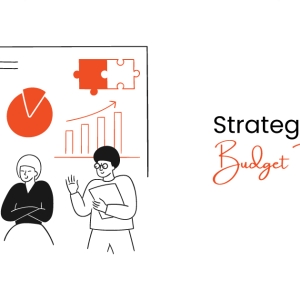Introduction
Software development projects are notorious for going over budgets, missing deadlines, and delivering low-quality products, which can have serious consequences for the clients, the developers, and the end-users. Therefore, incorporating a predictable budget is crucial to mitigate these risks and ensure successful project outcomes..
One of the key factors that affect the budget of a software project is its predictability. Predictability means that the project scope, requirements, timeline, and resources are clearly defined and agreed upon by all stakeholders. It also means that the project risks, uncertainties, and changes are minimized and managed effectively.
However, it requires careful planning, communication, collaboration, and monitoring throughout the project lifecycle. Here are some tips for improving the predictability of your software development projects and achieving more realistic and reliable budgets.
Importance of Predictable Budget
The bedrock of any successful development venture, whether in software, construction, or any other field, is financial predictability. A predictable budget is not just a financial document; it's a strategic tool that guides decision-making, resource allocation, and project planning.
It allows stakeholders to make informed decisions, secures investor confidence, and ensures resources are utilized efficiently. The unpredictability of budgets can lead to cost overruns, project delays, and in worst-case scenarios, the complete abandonment of projects.
Here are several statistics that suggest the same:
- The percentage of ERP projects with budget overrun issues in 2022 was 41%, while that in 2021 was 60% and 2017 was 74%.
- 57% of projects fail due to problems with communication.
- 39% of the projects fail due to lack of planning.
Thus, establishing mechanisms for creating a budget that is more predictable is paramount for the sustainability and success of development ventures.
Common Causes of Budget Problems
There are many factors that can affect the budget of a development venture, but some of the most common ones are:
- A poor plan can lead to unrealistic expectations, inaccurate estimates, missing requirements.
- Without a proper plan, you will not have a clear vision of what you want to achieve.
- It is very hard to establish priorities without a plan.
- Communication is essential for any development venture.
- Communication issues lead to bad coordination, conflicts, errors and rework.
- Changing customer needs, stakeholder pressure, market competition lead to scope creep.
- Risks can have a negative impact on a software development process.
- Unforeseen risks arise from legal issues, environmental factors, human errors, or external events.
- Uncertainties, variables, and several assumptions lead to poor project estimation.
- Failure to use project management tools and strategies.
- Failure to allocate sufficient resources or lack of required skill.
- Project complexity is a common factor and often leads to delays in the project.
- A failure to communicate clearly can lead to misunderstandings, conflicts, errors, duplication of work, missed deadlines, and wasted resources.
- Lack of testing or not enough testing often increases the number of bugs and errors in the code.
- Flaws in your project design only come to light at a later stage in the project.
- Issues in the project's performance on completion will require additional efforts to optimize it.
Essential Tips for Accurate Budgets
Initial Planning and Analysis:
- Define Clear Objectives:
- Begin with a clear understanding of the project's goals and requirements.
- Ambiguity leads to scope creep, which is a primary cause of budget overruns.
- Changes to scope and runtime changes are inevitable.
- Stakeholder Engagement:
- Early involvement of all stakeholders ensures that all perspectives are considered, reducing the likelihood of costly changes later in the project.
- Define the method and frequency of communication.
- Communicate using good software tools to provide regular updates.
- Market Analysis:
- Understanding the market environment can help in creating a more accurate and realistic budget.
- Several other external factors can affect the project as well.
Cost Estimation Techniques
- Top-Down vs. Bottom-Up Estimating:
- Top-down approaches provide a quick estimate based on project outcomes.
- Bottom-up estimating involves detailed analysis of every task and resource, offering more accuracy.
- Parametric Estimating:
- This technique uses statistical relationships between historical data and other variables.
- Consider past projects and learn from the mistakes.
- Three-Point Estimation:
- This method considers the best, worst, and most likely cost scenarios.
The Role of Contingency Planning
- Risk Analysis:
- Identifying potential risks and their impact on the project budget allows for the creation of more realistic budgets.
- This is a good way to accommodate unforeseen expenses.
- Contingency Funds:
- Allocating a portion of the budget for unforeseen circumstances is a prudent practice.
- The size of the contingency fund can be determined based on the risk profile of the project.
Financial Monitoring and Control
- Regular Budget Reviews:
- Conducting regular budget reviews helps in identifying variances early.
- Allows adjusting the budget or project plan as necessary.
- Project Metrics:
- Monitoring and controlling the budget is an ongoing activity that involves measuring the actual performance of the project against the planned performance.
- Identifying any variances or deviations from the budget baseline and analyzing their causes and effects.
- Use tools to help identify measurable parameters.
- Define KPIs for the project's success.
- Regularly track project progress and expenses against the budget to identify and address issues early.
- Identify potential risks and develop strategies to mitigate their impact on the budget.
Leveraging Technology for Budget Management
- Project Management Software:
- Tools like Microsoft Project, Asana, or Jira provide real-time visibility into project progress and financial status, facilitating better budget control.
- Implementing automated budgeting tools reduces manual effort and minimizes the risk of errors.
- These tools can streamline the creation, tracking, and updating of budgets, ensuring accuracy and efficiency in financial management.
- Advanced reporting and analytics tools provide real-time insights into project finances.
- It enables project managers to monitor expenditures, track variances, and make data-driven decisions promptly, mitigating the risk of budget overruns.
- Financial Management Systems:
- Integrating project management with financial management systems ensures that budget data is accurate and up-to-date
- This allows for more informed decision-making.
- Cloud-Based Collaboration:
- Cloud-based project management platforms facilitate seamless collaboration among team members regardless of geographical locations.
- This enhances communication on budget-related matters, fosters transparency, and ensures that everyone is on the same page.
- Forecasting and Predictive Analytics:
- Utilize forecasting tools and predictive analytics to anticipate future expenses and identify potential budget risks.
- By analyzing historical data and trends, project managers can make informed decisions to proactively manage financial challenges.
- Artificial Intelligence (AI) can analyze vast datasets to identify patterns and optimize budget allocation.
Fostering a Culture of Financial Accountability
- Training and Education:
- Ensure that project managers and team members are trained in managing budgets and financial literacy
- Foster a culture of accountability.
- Incentives for Budget Adherence:
- Implementing incentives for meeting or coming under budget can motivate teams to monitor and control spending closely.
- Transparent Communication:
- Regularly communicating financial performance to all stakeholders helps in maintaining trust and encourages a proactive approach to managing budget variances.
Establish a clear change management process:
- Continuous Monitoring:
- Implement a system for continuous budget monitoring.
- Regular monitoring allows for early identification of potential deviations.
- Enables timely adjustments and maintaining financial predictability.
- Proactive Risk Management:
- Identify and address potential risks proactively.
- A robust risk management strategy minimizes the impact of unforeseen challenges, contributing to budget predictability.
- Adaptive Budgeting:
- Establish a clear change management process.
- Changes to project scope are inevitable.
- A formalized process ensures that budget adjustments are made with careful consideration.
- Post-Implementation Reviews:
- Conduct post-implementation reviews to assess budget performance.
- Learn from past projects, identify areas for improvement, and refine budgeting processes for future ventures.
Budgeting is a crucial skill. The more predictable your budget is, the easier it is to avoid cost overruns. But budgeting can also be challenging, especially when you have to deal with unpredictable factors such as market fluctuations, customer demand, or unexpected costs.
Following the tips above will lead to creating a more predictable budget and prevent cost overruns. However, it is best to hire remote developers for your software development requirements.
Acquaint Softtech is a software outsourcing company. We have over 10 years of experience delivering flawless solutions to clients all over the world.
Conclusion
predictable budget for your software development project is a multifaceted process. It requires meticulous planning, accurate cost estimation, effective risk management, diligent financial monitoring, and a culture of accountability.
By adhering to these strategies, organizations can significantly enhance their ability to manage budgets effectively, ensuring the success and sustainability of their projects.
While challenges are inevitable, the ability to navigate financial uncertainties with agility and foresight can distinguish successful ventures from those that falter under the weight of financial unpredictability.






